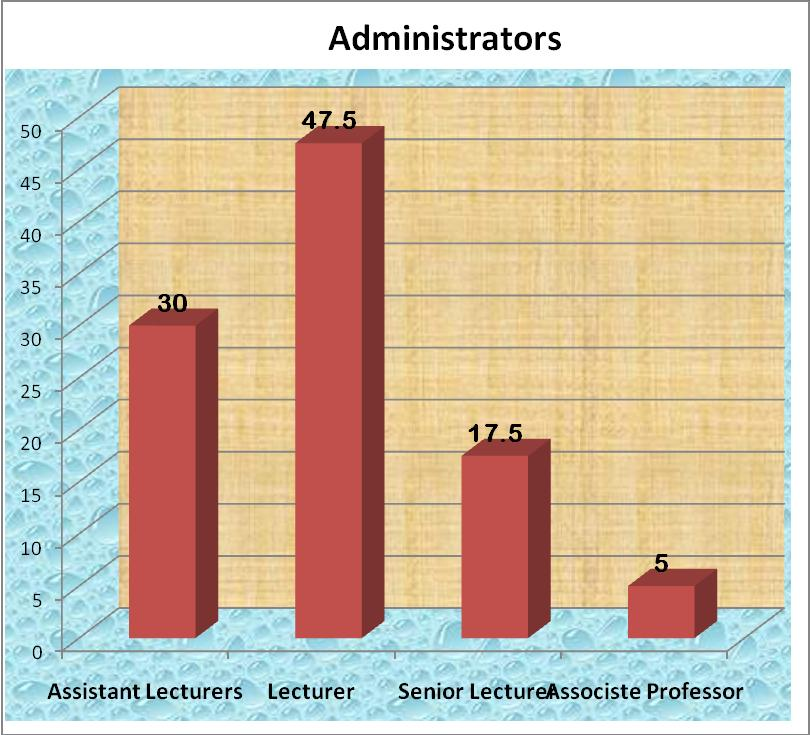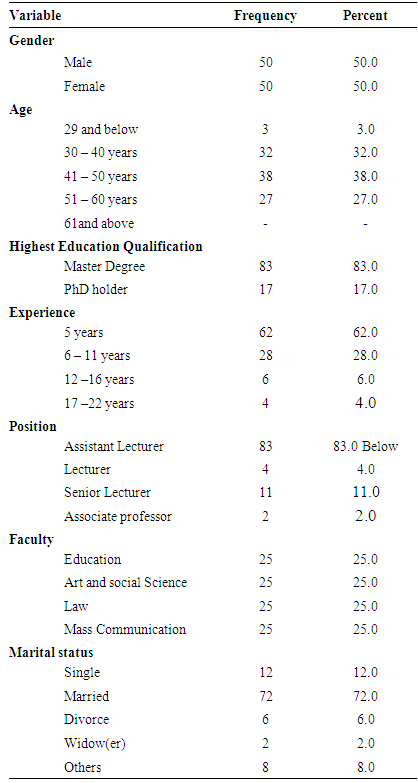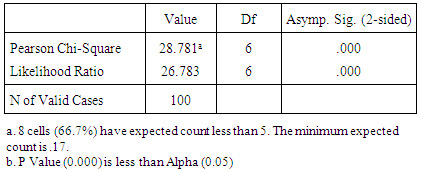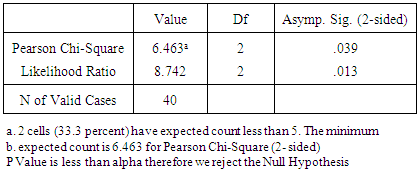-
Paper Information
- Paper Submission
-
Journal Information
- About This Journal
- Editorial Board
- Current Issue
- Archive
- Author Guidelines
- Contact Us
American Journal of Sociological Research
p-ISSN: 2166-5443 e-ISSN: 2166-5451
2017; 7(2): 77-84
doi:10.5923/j.sociology.20170702.03

Workplace Administrative Strategies for Retention of Academic Staff in Private Universities in Southern Highlands Zone, Tanzania
Demetria Gerold Mkulu1, Jacinta M. Adhiambo2, Theonestina Katundano3
1Faculty of Education Foundation, St Augustine University of Tanzania, Mwanza, Tanzania
2Faculty of Education, The Catholic University of Eastern Africa Nairobi, Kenya
3Centre for Social Justice and Ethics, The Catholic University of Eastern Africa Nairobi, Kenya
Correspondence to: Demetria Gerold Mkulu, Faculty of Education Foundation, St Augustine University of Tanzania, Mwanza, Tanzania.
| Email: |  |
Copyright © 2017 Scientific & Academic Publishing. All Rights Reserved.
This work is licensed under the Creative Commons Attribution International License (CC BY).
http://creativecommons.org/licenses/by/4.0/

This study aimed at exploring workplace environment administrative strategies for retention of academic staff in private Universities in Southern Highlands Zone in Tanzania. Retaining employees remain a serious concern in higher education. This study was guided by the following research questions: What workplace administrative factors affect academic staff retention in private universities in Southern Highland’s zone in Tanzania? What administrative strategies have been put in place by private universities to enhance retention of lecturers in Southern Highland zone in Tanzania? The study was based on Herzberg theory. It adapted mixed methods research design, specifically convergent parallel mixed methods research designs. Cross sectional survey and phenomenology were employed. A total of 250 respondents from five private universities participated in the study. The major research instruments used were questionnaires which had a Cronbach’s Alpha coefficient of α = 0.930 implying that the instruments were reliable. Other instruments used included in-depth interview guide and document analysis guide. The Statistical Package for Social Sciences Version 21.0 was used in analysis of quantitative data. The data was analyzed using descriptive statistics such as frequencies, percentages, means and standard deviations while inferential statistics, included Chi- Square test for association and the results were presented using tables. Qualitative data was analyzed using open coding, axial coding, meaningful themes and summarization of data. The results indicated that workplace factors, administrative strategies contributed to academic staff retention. The findings also indicated that private universities in Southern Highland Zone had very low lecturers’ retention. The study recommended that management of private universities should as much as possible provide attractive workplace environment.
Keywords: Workplace Environment, Administrative, Retention, Academic Staff
Cite this paper: Demetria Gerold Mkulu, Jacinta M. Adhiambo, Theonestina Katundano, Workplace Administrative Strategies for Retention of Academic Staff in Private Universities in Southern Highlands Zone, Tanzania, American Journal of Sociological Research, Vol. 7 No. 2, 2017, pp. 77-84. doi: 10.5923/j.sociology.20170702.03.
Article Outline
1. Background to the Study
- Academic staff retention in private universities is a serious concern (Selesh & Naile, 2014). Private universities in Southern Highlands zone of Tanzania continue to experience very low lecturer retention. This has raised deep concern among university managers, administrators, parents, students and other stakeholders (United Republic of Tanzania, 2013). Poor academic staff retention has a direct effect on learners’ performance as universities loose quality lecturers and it takes time to get replacements. The educational report from United Republic of Tanzania (2013) indicates that private universities suffer more than other sectors. However, the Tanzanian Development Vision (2025) intends to give high priority to education and make Tanzania a centre of excellence. In addition, the United Republic of Tanzania (2013) asserts that despite efforts by the Ministry of Educational and Vocation Training (MoEVT) to retain human resources, there is very low lecturer retention. The private sector alone has 66.1 percent of lecturer turnover from private universities. A similar report from Basic Education Statistics in Tanzania (BEST, 2011) reveals that there is high academic staff attrition. The current study was anchored on Herzberg Theory of motivation (1959). According to Herzberg, employees’ needs can be categorized into two factors, namely hygiene and motivators. This theory gives guidelines to university managers on providing conducive environment to workers and promotes growth at the workplace taking into account what lecturers want from their work. The theory provides strategies for employees’ retention in private universities. Today, employees’ retention is the top priority of organizations due to increasing competition (Maliposa, 2014). However, workplace has a positive or negative impact on academic staff retention or attrition. Tickle (2009) conducted a study on workplace environment and the contribution to lecturer turnover in United States. It was found out that working condition, low remuneration and learners’ indiscipline led to low retention of academic staff in universities. Whereas Tickle’s study was done in a developed country, the current study was conducted in a developing African country. It employed mixed methods research paradigm for the purpose of triangulation to determine if it would arrive at similar findings. In relation to this study, Ravenswood, Markey, and Webber (2012) examined the impact of the quality of workplace environment on workers’ plan to leave the workplace environment. The study indicated that participants felt that workplace environment was not conducive. In addition, the study demonstrated that leadership styles led employees’ decision to quit. Furthermore, Alfes, Shantz, Truss, Soane, (2013) revealed that a workplace that allows people to participate in decision making increases job satisfaction and empowers employees to be more committed. It was in this regard that the researcher wanted to find out if similar findings could be found in Southern Highland zone in Tanzania. In a similar study, Akanbi (2013) examined the influence of intrinsic and extrinsic motivation on workers’ performance in Oyo State, Nigeria. The findings indicated that working environment, academic staff training, remuneration, and recognition, transparent conditions of service, and components of salary structures were key strategies for retention. The current study used mixed method research design with questionnaires, interviews and document analysis as tools for data collection.A study by Wambui (2014) measured the influence of management practices on lecturers’ retention at Kenyatta University in Kenya. The results showed that there was positive relationship between employee training, recruitment, lecturer’s welfare, facilities, academic staff career development and lecturer retention. It also noted that training empowers lecturer’s retention and decreases turnover. However, this study used a single, public university. A case study whose findings cannot be generalized to other Universities. The current study focused on five universities in southern highland zone in Tanzania. By using the mixed methods research design, it allowed the researcher to examine more closely and deeply the cultures of different private universities that directly and indirectly contribute to staff attrition or retention.Another related study by Namasaka, Wesangula and Mamuli, (2013) examined factors responsible for lecturer turnover at Masinde Muliro University of Science and Technology in Kenya. Using a single case study. The study revealed that most academic staff members were dissatisfied due to poor conditions of work, insufficient career development, few opportunities for growth, and a perception of being devalued and unrecognized. Namasaka et al, did not indicate which instruments were used and the methodology employed. This makes it difficult to generalize its findings to an entire population. In addition, the study did not indicate the sampling procedures used, the current study used probability and non-probability sampling to determine the influence of the working environment on academic staff retention in private universities in Southern Highland Zone, Tanzania.In Kenya, Nderitu (2014) examined lecturer retention in two Christian sponsored universities. The target population was full time faculty in three departments: Biblical, Counseling, and Business. Questionnaire, interviews guide and document analysis was used for data collection. Purposive sampling was employed to select the two Universities used in the study. The findings demonstrated that academic staff lacked freedom. The universities had a very low number of lecturers.Findings from Nderitu’s study failed to indicate the real sample size. In addition, the study had a limited scope since it focused only on two Christian sponsored universities. The current study filled the gap by using five private both non-Christian and Christian universities out of ten universities with the sample size of 250 participants.The Governance and Social Development Resource Centre (GSDRC, 2010) conducted a study on academic staff retention in public universities in Tanzania. The key findings showed that Tanzanian universities have very low levels of funding. Hence the universities could not offer competitive terms of service due to low levels of funding. Similarly, study observed that both monetary and non-monetary rewards in universities influences staff motivation. However, this study did not indicate the methodology used.While exploring on challenges facing academic staff in Tanzania, Mkude (2007) included private and public higher education institutions. The findings indicated that remuneration and conditions of service were the key issues that affected lecturers in Tanzania. They received very low salaries compared to the work done. Although opportunities for career development were provided to academic staff, 90 percent of their salary was retained. Furthermore, the study revealed that brain drain in Tanzania was due to low remuneration and poor working conditions. The current study would determine whether the findings by Mkude (2007) can be applied to the Southern Highland Zone.Administrative Strategies for Retention of LecturersIn Washington, USA, Lee, Eberly and Terence (2008) conducted a study on retention of lecturers. The study indicated that recruitment and retention of high-quality academic staff is more important today than before. Universities across the globe have emphasized the importance of retaining potential lecturers for university success. The study findings demonstrated that employees who perform better in the workplace are believed to have external employment opportunities available to them; hence they are more likely to leave. Lee et. al., observe that turnover in general is disruptive and costly. This is supported by Shrm (2012) and the Task Force Report on Teachers for All, TFA (2010). The weakness of Lee et al.’s (2008) study is that it failed to indicate the methodology used. Also, it should be noted that this study was conducted in a developed country that is in USA. These are key gaps which the current study sought to fill.In addition, Calhoun (2009) assessed on job satisfaction and employee turnover, among state university lecturers in Olabisi Onbanjo University in Nigeria. Calhoun used a single instrument that is questionnaire, to collect information. The study findings indicated that gender influence on work-family roles contributed to lecturers’ decision to leave the university. Other findings were that employee attrition at the workplace was caused by lack of motivation, job insecurity, and large class sizes. The current study employed used both quantitative and qualitative methods which encourage the use of multiple world views and is therefore more pragmatic.In the same line Sives (2006) reported on lecturers, brain drain and educational resources in three Commonwealth countries, namely Jamaica, South Africa, and Botswana. The research framework was designed to explore both quantitative and qualitative impacts of lecturer turnover. The findings indicated that professional development and salary were the two main reasons why lecturers migrated to developed countries. It was also found out that 27.5 percent of lecturers wanted to work abroad after qualifying while 48 percent of lecturers in the universities also expressed an interest in working in developed countries. The previous study used only three countries out of 53 Commonwealth countries. This means that findings from this study cannot be generalized.In related study, Amutuhaire (2010) investigated the effect of remuneration on job retention for academic staff at Makerere University in Uganda. The study was anchored on the quantitative approach and used questionnaire to collect data from 159 lecturers. The findings showed that lecturers’ intentions to retain their job depended on satisfaction, remuneration, and job security. Amutuhaire recommended that university managers should devise means of making employment contracts more satisfying, remuneration packages more attractive and lecturer’s jobs very secure. The main limitation of Amutuhaire’s (2010) study was that it was based only on the quantitative approach and sampled a single university. To eradicate this weakness, the current study employed mixed methods research paradigm that is ideally different but essentially complimentary in a single study (Onwugbuzie and Wao, 2011). Furthermore, the current study used five universities out of ten.Another study by Ishengoma (2010) researched on internal brain drain and its impact on higher education institutions, capacity building and human resource development. Basing his study on Tanzania, the researcher used a case study design on a single institution, University of Dar es Salaam’s department of Education. The study focused on the movement of lecturers from old public universities to newly established public ones. The study revealed that the movement was eroding the human resource base of old universities, particularly the University of Dar es Salaam.
2. Research Methodology
- The study adopted convergent parallel Mixed Methods Research Designs. The designs allow quantitative and qualitative data collection in parallel then data from the different tools of data collection were analyzed separately and later merged for comparison and interpretation of the overall results as proposed by (Creswell, 2014; Onwugbuzie and Wao, 2011). MMRDs allowed the researcher to examine more closely and deeply cultures of different private universities that directly and indirectly contributed to academic staff retention or attrition. Both quantitative and qualitative methods had equal weighting in addressing the research problem. Quantitative data was gathered as per descriptive survey research design, while phenomenology design took care of the qualitative aspect of the study. The mixed methods facilitated the collection and analysis of data on cultural dynamics of the specified academic environment that could lead to attrition, and seek suggestions for retention. The study preferred the qualitative approach because it provided detailed data about human behavior and emotion, something that the quantitative approach may not achieve. Phenomenology design, according to (Joarder & Yazam, 2013) allowed the researcher to hear the concern of interviewee when they responded to the open-ended research questions. The researcher exploited the strengths of cross sectional survey to collect complimentary data that were reducible to meaningful inferable numbers. This study was confined to private universities in southern Highlands Zone in Tanzania. The target population in this study consisted of all academic staff, administrators, third year university students and Human Resource Managers in the Southern Highlands Zone. Participants were full time academic staff with a minimum service period of two years and above. This population was considered adequate to provide key information pertinent to the objectives of the study.Sample size and Sampling ProcedureBoth probability and non- probability sampling were employed in the study. The study sampled 100 academic staff, 40 administrators, 100 university students and 10 Human Resource Managers, giving a total of 250 participants. Research InstrumentThe current study employed the questionnaires, interview guide and document analysis guide.
3. Findings and Discussion
- This section presents the research findings on workplace, administrative strategies for retention of academic staff in private universities in Southern Highlands Zone in Tanzania. A detailed account and discussion of findings within the key thematic areas of the study have been presented. The finding on the demographic variables of the academic staff results are shown in Table 1.
|
 | Figure 1. Administrators by Position |
|
3.1. Null Hypothesis (H0) One
- The study was interested to find out the relationship between workplace and academic staff retention.
|
3.2. Null Hypothesis (H0) Two
- There is significant relationship between administrative strategies and retention academic staff in Southern Highland zone, Tanzania. A Chi- Square test was used to test the second null hypothesis. The results are as presented in table 4 below the test for null hypothesis was done using Chi- Square. The main findings of the research were summarized and presented based on the themes of research questions:
|
4. Conclusions
- The purpose of this study was to examine workplace administrative strategies for retention of academic staff in Private University in Southern Highland Zone in Tanzania. The researcher made the following inferences:Firstly, workplace in private universities fell short in several areas such as very low remuneration, career development, lack of promotion based on performance, insecurity, lack of appreciation at the place of work, very poor and not competitive remuneration which was evidenced by most respondents thereby leading to very low academic staff retention.Secondly, most of the private universities in Southern Highland Zone had no specific administrative strategies and where they existed they were not dully implemented. In addition, the study findings indicated that management in private universities in Southern Highland Zone in Tanzania do not support or improve work environment by adopting enhancement programs, competitive remuneration, rewards, training, recognition, good communication between academic staff and employers as well as good relations between management and lecturers. Private universities that were sampled did not have up- to date and well-articulated academic staff development plan geared towards achieving their ambitions and the needs of individual department and their members of staff.
5. Recommendations for Practice
- Based on the findings and conclusions of this study on workplace, administrative strategies for retention of academic staff in private universities, the study brought forth a number of concerns that require the attention of stakeholders in seeking measures to curb the issue of academic staff retention in private universities using the following recommendations:i. That the management of private universities in Southern Highland Zone in Tanzania should as much as possible provide attractive workplace for employees to boost their decisions to stay within the organizations. Create a supportive culture in the workplace by offering, competitive remuneration, providing reward, training, recognition, good communication between academic staff and employers and good relations among colleagues. There is a need to adopt some of the creative ideas to mobilize resources from the public, private sectors, other stakeholders, as well as international partners, to help them improve remuneration.ii. There is a need for managers and administrators of sampled private universities to consider devising administrative strategies for retention and implementing it so as to attract the external and internal employees. Managers and administrators should treat employees with respect and trust; they should provide feedback on performance and recognize achievement done by the academic staff. It is recommended that employees be given fair treatment and high appraisal regarding promotion.
 Abstract
Abstract Reference
Reference Full-Text PDF
Full-Text PDF Full-text HTML
Full-text HTML


